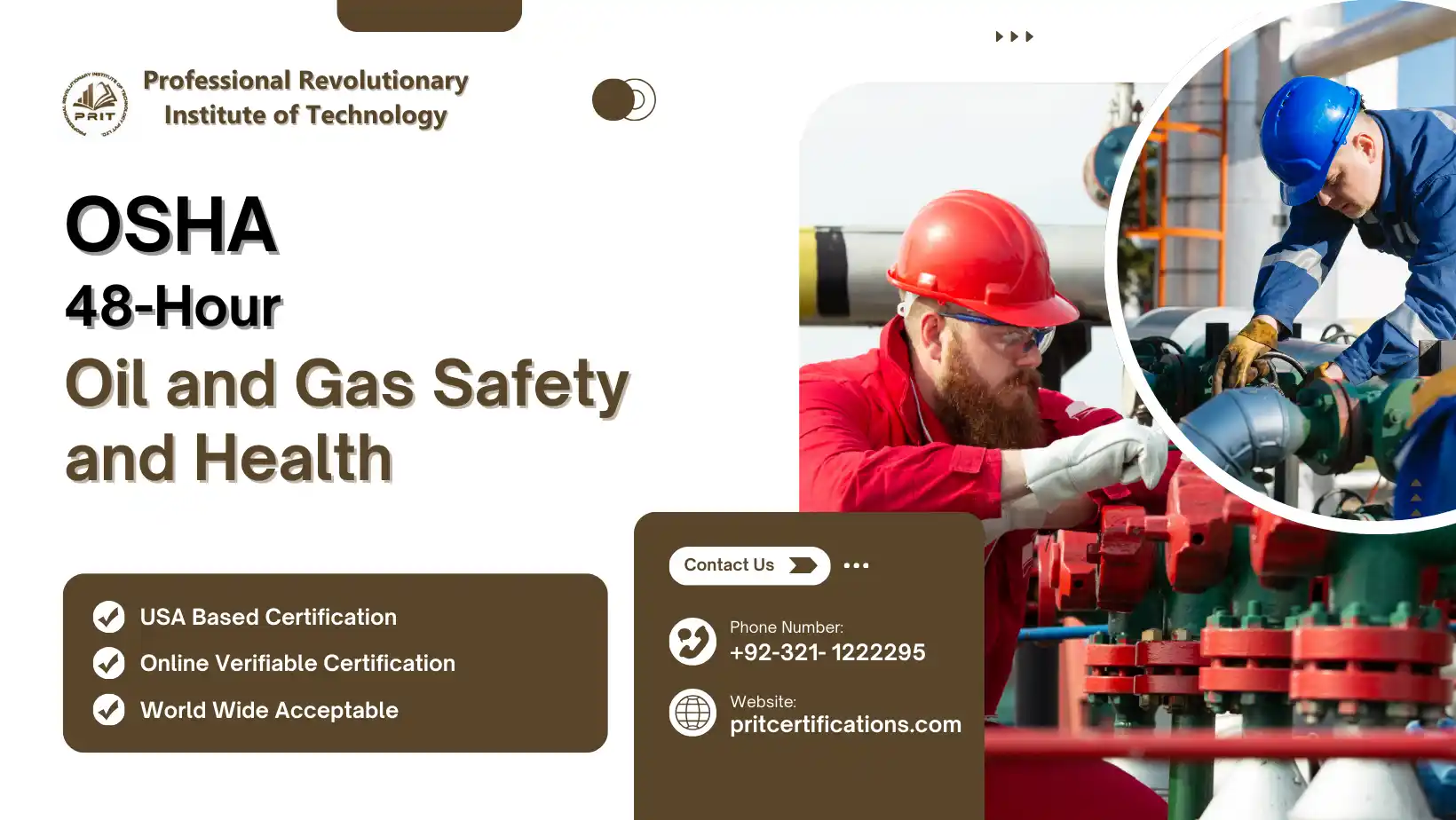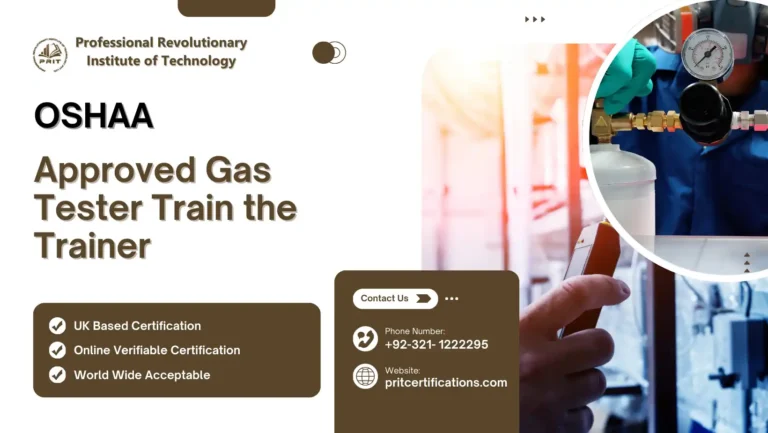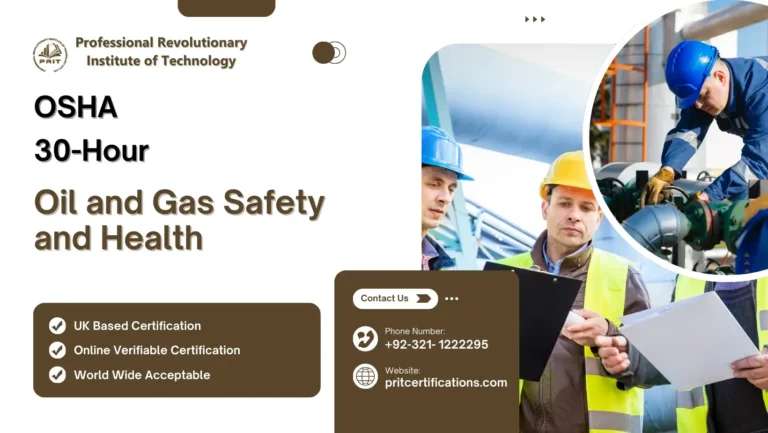
The OSHA 48-Hour Oil and Gas Safety and Health course is designed to provide professionals with essential knowledge and practical skills required to work safely in one of the most hazardous industries worldwide. The oil and gas sector presents numerous risks, including exposure to flammable materials, confined spaces, high-pressure systems, toxic chemicals, and complex machinery. This course equips learners with the competencies necessary to identify hazards, control risks, comply with regulatory requirements, and respond effectively to emergencies.
Through OSHA’s international framework, this training covers core areas such as hazard identification, process safety management (PSM), emergency preparedness, incident investigation, and environmental protection. Learners will also develop leadership skills that foster a proactive safety culture in oil and gas operations.
This program is suitable for professionals who want to enhance their occupational safety knowledge, ensure compliance with OSHA standards, and advance their careers in the energy sector. Upon completion, participants will not only be able to minimize workplace incidents but also contribute to sustainable and safe practices across oil and gas industries globally.
Course Overview
Qualification Title: OSHA 48-Hour Oil and Gas Safety and Health
Regulated by: OSHA – Occupational Safety and Health Standards
Guided Learning Hours (GLH): 48 hours
Credits: 15
Level: International Professional Certification
Mandatory Study Units
- Introduction to OSHA and Oil and Gas Industry
- Regulatory Compliance in Oil and Gas Operations
- Hazard Identification and Risk Assessment
- Personal Protective Equipment (PPE)
- Process Safety Management (PSM)
- Emergency Preparedness and Response
- Health Hazards in the Oil and Gas Industry
- Environmental Protection and Sustainability
- Safety Leadership and Culture
- Incident Investigation and Reporting
- Contractor Safety Management
- Tools and Equipment Safety
Learning Outcomes
By the end of this course, learners will be able to:
- Introduction to OSHA and Oil and Gas Industry
- Understand OSHA’s role in regulating oil and gas safety.
- Recognize the unique risks associated with oil and gas operations.
- Regulatory Compliance in Oil and Gas Operations
- Apply OSHA standards and international regulations in daily operations.
- Maintain compliance with industry-specific requirements.
- Hazard Identification and Risk Assessment
- Identify, analyze, and control hazards in oil and gas sites.
- Conduct professional-level risk assessments.
- Personal Protective Equipment (PPE)
- Select, use, and maintain appropriate PPE for various hazards.
- Train workers on proper PPE usage and limitations.
- Process Safety Management (PSM)
- Apply PSM principles to prevent catastrophic incidents.
- Develop and implement effective control measures.
- Emergency Preparedness and Response
- Create and implement emergency response plans.
- Coordinate drills and train teams for real-time response.
- Health Hazards in the Oil and Gas Industry
- Identify occupational health risks such as noise, chemical exposure, and ergonomics.
- Implement preventive and control strategies.
- Environmental Protection and Sustainability
- Manage environmental risks such as spills and emissions.
- Promote sustainability in oil and gas projects.
- Safety Leadership and Culture
- Develop leadership skills to promote a strong safety culture.
- Foster employee engagement and accountability.
- Incident Investigation and Reporting
- Conduct thorough incident investigations.
- Report findings and recommend corrective actions.
- Contractor Safety Management
- Monitor contractor and vendor safety compliance.
- Integrate contractors into organizational safety systems.
- Tools and Equipment Safety
- Ensure safe use and maintenance of tools and machinery.
- Train workers to recognize and prevent equipment-related hazards.
Entry Requirements
- A Level 3 or equivalent qualification in health and safety, engineering, or related field.
- Good English communication skills (reading, writing, and speaking).
- Basic knowledge of workplace safety principles.
- Prior experience in oil and gas, construction, or heavy industry is an advantage but not mandatory.
Course Benefits
- Gain an internationally recognized OSHA safety certification.
- Improve skills in hazard control, emergency response, and safety leadership.
- Enhance employability in oil, gas, petrochemical, and energy industries.
- Learn from globally recognized standards with real-world applications.
- Contribute to safer, more sustainable workplaces.
- Position yourself for career advancement in occupational safety.
Why Choose This Course?
- Comprehensive training in OSHA-based oil and gas safety standards.
- Blends theoretical knowledge with practical applications.
- Designed by industry experts for global professionals.
- Widely recognized certification in oil and gas safety.
- Enhances leadership and compliance skills.
Who Can Enroll in This Course?
This course is ideal for:
- Health and safety officers and supervisors.
- Engineers, technicians, and project managers.
- Oil and gas site inspectors and auditors.
- Contractors and safety coordinators.
- Graduates or professionals entering the oil and gas industry.
- Anyone seeking international safety certification.
Future Progression
Upon completing the OSHA 48-Hour Oil and Gas Safety and Health course, learners can progress to:
- Advanced OSHA certifications in oil and gas safety.
- Specialized training in Process Safety Management or Environmental Safety.
- Leadership roles such as HSE Manager, Safety Consultant, or Safety Engineer.
- Membership in international safety and occupational health organizations.
- Career opportunities in oil, gas, energy, and petrochemical industries worldwide.






